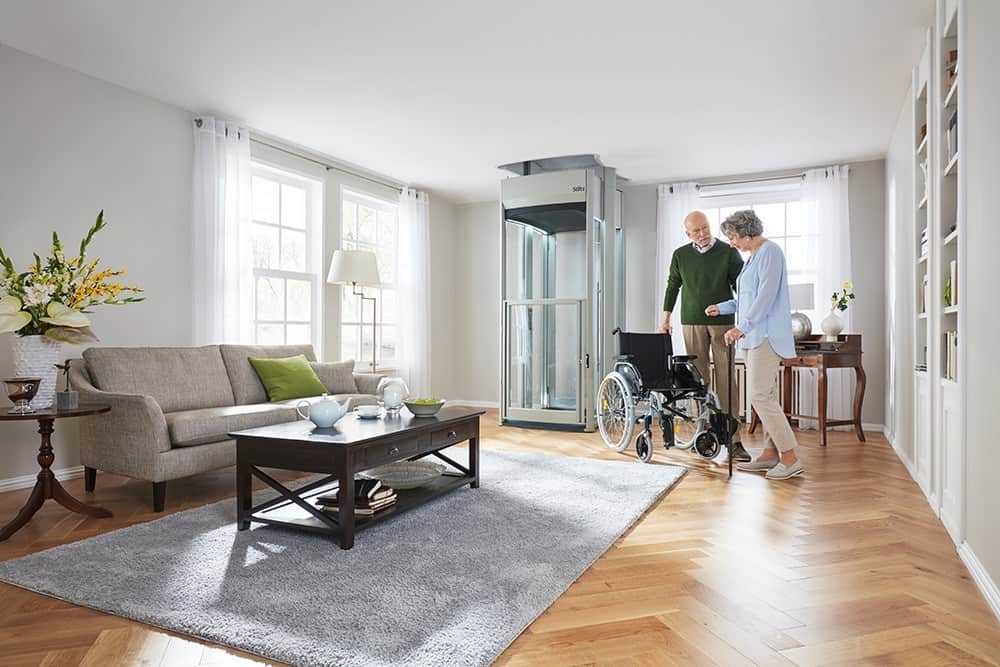The OT’s Perspective: Can your client use the DFG for a home lift?

If you’re not familiar with the Disabled Facilities Grant (DFG), then here’s what you need to know:
A DFG is there to pay for essential housing adaptations, such as a home lift, to help you stay in your home and live an independent life.
This article helps you consider if a home lift is right for your client, applying for a DFG and how you can best help your client in this scenario.
What is a home lift?
You might know it as a through-floor lift or domestic lift.
It’s basically a lift installed into your home, that helps you get from one floor to another, and there are various models available, depending on whether you need to access multiple floors, have limited space or use a wheelchair.
Over my years as an OT, I’ve helped plenty of clients to get home lifts installed in their home, many through the DFG.
A recent case springs to mind – in February I recommended a Stiltz Trio+ lift for one of my clients. He was using walking aids and a wheelchair, which made the Trio+ a perfect choice, as it can fit a standard-sized wheelchair in it.
When is a home lift the right solution?
- If your client is finding using stairs difficult and they are at risk of injury caused by a slip, trip or falls.
- If your client needs the freedom to move around their property with ease and wants to remain at home rather than being confined to the ground floor or relocating to a flat or bungalow. As most of us know, moving can be hugely expensive, which means that in many cases a home lift is more economically prudent.
- If your client doesn’t have the finance or inclination to build a bedroom and/or wet room on the ground floor of their existing property.
- If your client is a wheelchair user for whom transferring independently is difficult or simply not possible. I saw a sad story in a recent THIIS magazine article detailing how a vulnerable service user fell down the stairs and died transferring at the top of the stairs onto an older style stairlift.
- If your client needs to move heavy items between floors. This is helpful for clients living on their own, who can’t carry washing (and other items) up and down the stairs on their laps while using a stairlift.
Stairlift or home lift?
I’ve written about this in more detail in a THIIS magazine article back in April 2018 – you’ll be able to find it on the THIIS magazine website – but in general, home lifts are a safe, reliable, future-proofed alternative to stairlifts and are becoming increasingly popular.
Consider the following points before you select a home lift or stairlift:
- With a stairlift, clients need to feel confident about transferring independently to a stairlift seat, especially at the top of the stairs. Carer support can be offered with an adequate risk assessment, but we must consider reducing risk as far as is reasonably practicable, so if a home lift reduces risk significantly as opposed to a stair lift, a stair lift should not be considered.
- If the staircase is narrow and you have a stairlift installed, other members of the household may struggle to use the stairs safely, especially children or elderly family members.
- In some cases, a stairlift may not be suitable due to the design of your staircase.
- If your client’s condition is likely to worsen, it’s important to think about the future. If there is a chance your client may have balance issues or problems using a stairlift seat further down the line, you may wish to consider a home lift as most professionals do not carry out regular reviews of their client – what you recommend has to work for the foreseeable future.
- If the client chooses a stairlift and are a wheelchair user, they will likely require two wheelchairs, one upstairs and one downstairs.
You’ll also need ample space at the top and bottom of the stairs to position your wheelchair. I have used wheeled shower chairs for upstairs before for a solution, but this is not always appropriate and although the wheeled shower chair may go over the toilet and into the shower ok, transfer height may make stair lift transfer at the top of the stairs hazardous.
Is your client eligible for a DFG?
A DFG is there to pay for essential housing adaptations to help you stay in your home and live an independent life, and your client may be eligible for one.
The DFG assessment works out the need not the want, as well as whether the works are reasonable and practicable.
As a result, set categories of provision are considered by the assessor. In relation to the home lift recommendations, this may fall under the categories:
- Access to a bath and or shower (thus bathroom access).
- Access to a bedroom.
- In upside down houses, this could be access to a principle family room, kitchen and rear access to the property.
Here’s what you need to know about the DFG:
- It’s only available in England, Wales and Northern Ireland
- In Scotland you can apply for an equipment and adaptations grant
- It’s means-tested for adults, but will not affect any other benefits you receive
- Means-testing does not apply to disabled children under 18 so parents’ income will not be a factor
- You must own the property or be a tenant, with the intention to stay there at least five years
- The grant amount depends on household income and savings. The max grant is £30,000 in England, £36,000 in Wales and £25,000 in Northern Ireland.
- Your client will receive payments in instalments as the work progresses, or in full when the work is finished
Here’s how your client applies:
To apply for a DFG, your client needs to phone their local council and request an assessment. This application can be completed on their behalf – usually a local agency will attend and complete the paperwork if needed.
Your next step
If you’d like to know more about the DFG, then we’d love you to join us at our Introduction to Disabled Facilities Grants training session on November 11th 2020 in South Wales. You can get more information and book your place by calling us on 02921 900402, or emailing us at info@promoting-independence.co.uk

Stuart Barrow of Promoting Independence is a member of the British Association of Occupational Therapists panel and a recognised contributor in the field of home adaptations. His experience is sought by manufacturers and service providers looking for an expert opinion. He also runs the Occupational Therapy Adaptations Conference

